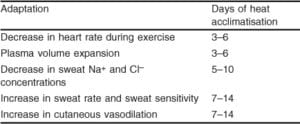Europe may have experienced the hottest temperature ever recorded this summer. It is forecast that sweltering summers could become more common in the future as a cause of man-made climate changes.
What are the effects of raising temperatures on our human body systems?
How does the human body acclimatise to heat?
Thermoregulation research
Thermoregulation studies in humans are conducted with special rooms at Maastricht University. These rooms are whole-body room calorimeters with highly controlled environment, with the ability to control temperature, humidity, light, sleep rhythm and many other factors. This enables the investigation of energy metabolism both under controlled conditions in a laboratory setting and in the “natural” environment.
Dr. Wouter van Marken Lichtenbelt, Professor of Ecological Energetics and Health at Maastricht University, who conducts such studies was recently interviewed by De Limburger, a news provider oriented towards the province Limburg in the Netherlands, about the summer heat. This article touches on a few research topics that were discussed.
Heat stress
Heat stress is most relevant during physical exertion in the heat, hence heat research tends to focus on the effect of heat on physical training. Dr. Wouter van Marken Lichtenbelt shared his account during his stay in Curaçao a long time ago. The Marines are known to climb the Christoffel mountain too quickly after arrival, when they have not sufficiently acclimatised, and suffer a heat stroke as a result. Dr. Wouter van Marken Lichtenbelt advised that heat stress should not underestimated, certainly not in combination with exercise.
 Heat acclimatisation involves a complex adaptation response as protection against hyperthermia. This includes increased sweat rate, peripheral vasodilation, decreased heart rate, perceived exertion as well as increased plasma volume. These adaptations serve to reduce physiological strain, improve an individual’s ability to perform work in a hot environment, and reduce the incidence of some forms of heat illness. Acclimatisation could take several days to about two weeks.
Heat acclimatisation involves a complex adaptation response as protection against hyperthermia. This includes increased sweat rate, peripheral vasodilation, decreased heart rate, perceived exertion as well as increased plasma volume. These adaptations serve to reduce physiological strain, improve an individual’s ability to perform work in a hot environment, and reduce the incidence of some forms of heat illness. Acclimatisation could take several days to about two weeks.

Humidity
Heat loss by evaporation of sweat is the primary means of heat dissipation when ambient temperature is high. The humidity makes a huge difference as sweat can only be effective for cooling if it evaporates. This means that when the relative humidity in the air is low (dry air), sweat will evaporate relatively fast. On the other hand, a high relative humidity of the surrounding air hinders the evaporation of sweat, leading to accumulation of sweat with little loss of body heat. The adaptations of sweat glands are distinctly different during dry and humid heat exposure.
Metabolism
Metabolism, which provides the energy source for muscular movements, is a major internal source of heat and increases with activity level. Research on the effect of heat on metabolism is mostly focused on physical training under extreme weather conditions, while less is known about the effects of temperature variations on energy metabolism during normal daily functions. Since people nowadays spend a majority of the time exposed to indoor conditions, Dr. Wouter van Marken Lichtenbelt and researchers from Maastricht University believe that health aspects of ambient temperatures warrant exploration.
“What would it mean if we let our bodies work again to control body temperature?." - Pieter Kubben
Dr. Wouter van Marken Lichtenbelt suggested that bouts of temperature stress might be beneficial to the individual, as it increases general stress resistance to temperature changes. He termed this “temperature training”. In addition, the team recently published in the journal Trends in Endocrinology & Metabolism with evidence suggesting that regular exposure to mildly cold air may help people lose weight. Frequent exposure to mild cold can boost energy expenditure as a response to maintaining the body’s core temperature. Furthermore, the researchers are studying other effects of environmental temperature on the thermophysiology and the cardiovascular system.
Technology for thermoregulation research
The whole-body room calorimeters at Maastricht University has a state of the art climate control that enables users to perform a broad range of thermoregulation studies such as metabolism in relation to temperature, lifestyle, exercise, light etc. Furthermore, the whole-body room calorimeters provides an optimal setting to perform translational research aimed at understanding the development of metabolic diseases such as obesity, diabetes and other chronic disorders. This system delivered by Maastricht Instruments is the most versatile system on the market that can be used for multiple applications. Along with ever-evolving research, the facilities in the rooms can be easily modified by changing settings or adding accessories.
References
Armstrong, L. E., & Maresh, C. M. (1991). The Induction and Decay of Heat Acclimatisation in Trained Athletes. Sports Medicine, 12(5), 302-312.
Lichtenbelt, W. v. M., Kingma, B., van der Lans, A., & Schellen, L. (2014). Cold exposure – an approach to increasing energy expenditure in humans. Trends in Endocrinology & Metabolism, 25(4), 165-167.
Wendt, D., van Loon, L. J. C., & Marken Lichtenbelt, W. D. (2007). Thermoregulation during Exercise in the Heat. Sports Medicine, 37(8), 669-682.
Contact us to find out more.
